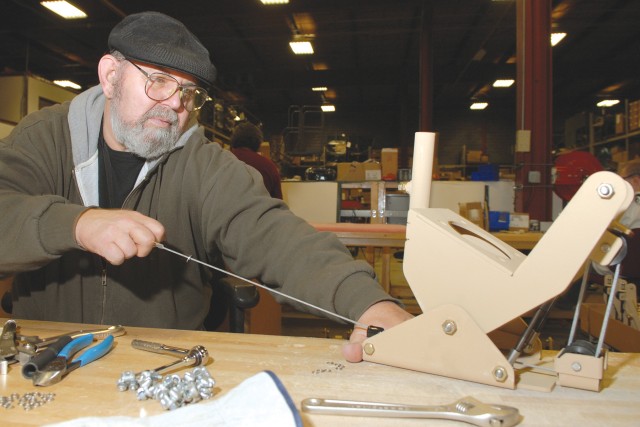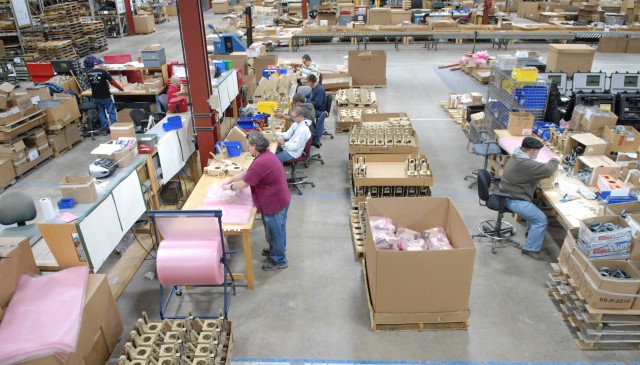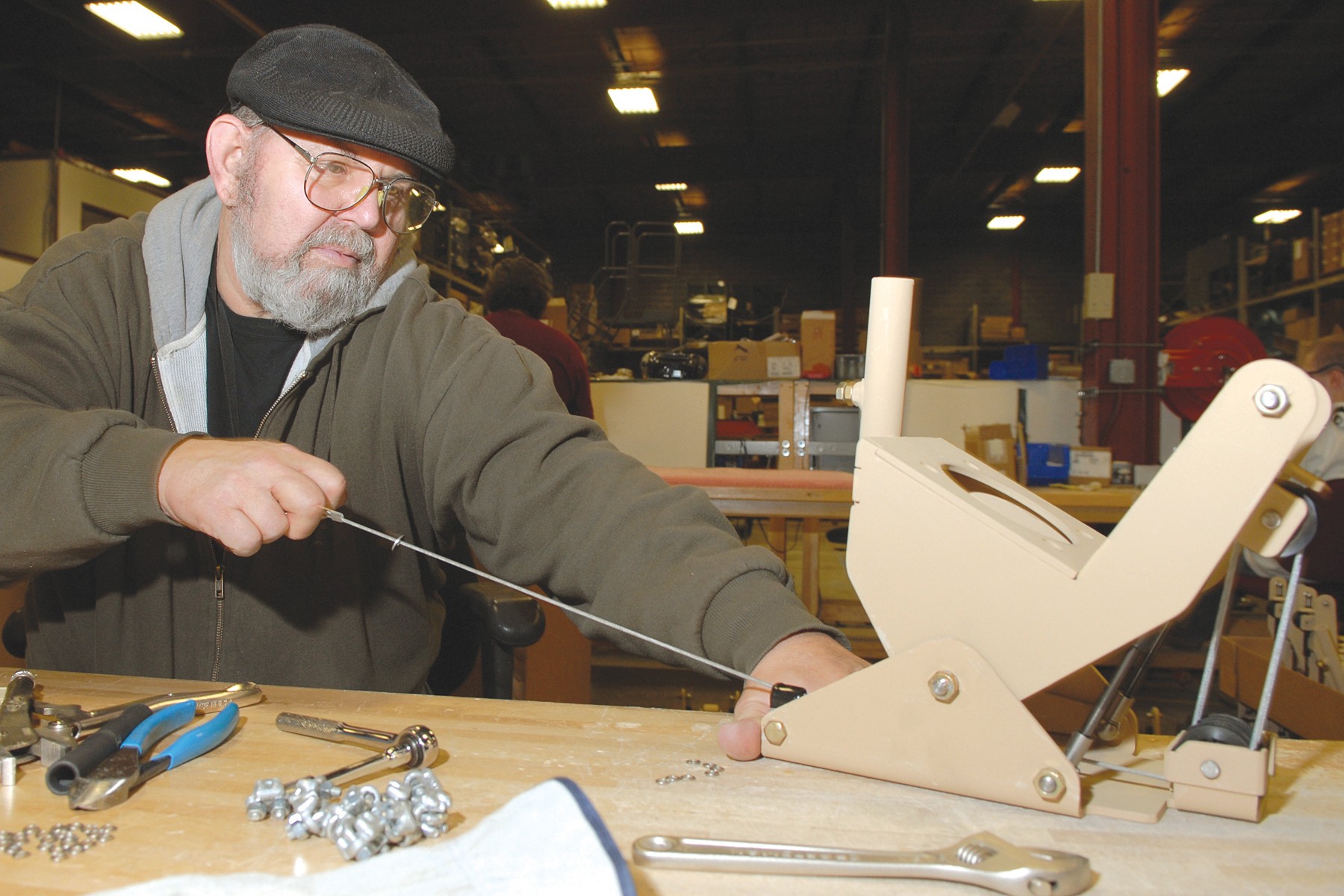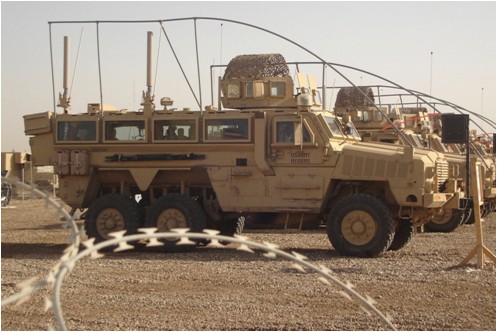TOBYHANNA ARMY DEPOT, Pa. - Dozens of employees at Tobyhanna have teamed up to fabricate, assemble and ship 12,500 retrofitted and new antenna flex-mount devices to Army and Navy units serving in Southwest Asia.
Last year, the depot joined forces with the product manager of the Counter Radio Controlled Improvised Explosive Device Electronic Warfare antenna systems, Fort Monmouth, N.J., to install a pull-down kit assembly on 5,000 devices, and then redesign and fabricate 7,500 new devices.
"Initially, we worked with a vendor to produce the retrofitted devices," said David Marcus, logistics management specialist, explaining that the vendor provided the flex-mount and employees here produced and attached the pull-down assembly.
"For the new design, we integrated the flex-mount and pull-down assembly into one piece that's manufactured at Tobyhanna." Marcus is assigned to the Production Management Directorate.
Radio controlled improvised explosive devices are a common threat to lives in deployed locations. The CREW antenna system is designed to jam communication signals between the remote control and the receiver used to detonate improvised explosive devices. The pull-down assemblies are used to protect the antennas from being damaged while Soldiers traverse the war zone in military vehicles.
"These are the hottest things going out right now," said Tim Knabel, mechanical engineer, Production Engineering Directorate. "There's a need for these devices overseas, so we're shipping them as fast as we can." Each flex mount costs less than $500 to manufacture.
Before work on the flex mounts began, PM CREW representatives approached the depot with an idea to develop an internal device that Soldiers could use to pull down the antenna. The pull-down assembly allows the antenna to tilt down prior to coming into contact with a hard object such as an overpass, bridge or low-hanging wires.
"They came to us with their design," Knabel said. "The flex mount was an existing piece of equipment, but they wanted to be able to manually pull down the antenna from inside the vehicle. We worked with them to get the best solution and that's where the retrofit kit idea came from."
Today the depot fabricates all the parts from steel except the wire rope, struts and pulleys, which are purchased.
Paul Keller spends much of his time assembling the flex-mount devices that support the CREW system antennas.
"Overall it's been a very rewarding job experience. Knowing the troops in the field depend on these units for their survival," he said. Keller is a sheet metal worker.
The large antennas that are part of the CREW system are mounted to an antenna flex mount device on an Mine Resistant Ambush Protected or other military vehicle.
While inside the vehicle, a driver or passenger can lower the antenna by pulling a handle which is connected to a 9-foot-long wire rope (attached to each assembly).
"This has been a great project," said Tom Nawrocki, mechanical engineering technician, PE Directorate. "Everyone provided input and we got to see it go through testing."
Depot officials agree the job was a team effort. Shops including sheet metal fabrication, welding, plating, painting, fabric applications, and sheet metal assembly played a vital role in the process.
Workers in the Assembly Branch remarked that the volume of work, at times, was overwhelming; however, knowing that warfighters would be using the device provided the incentive they needed to keep going until the job was finished.
The Systems Integration and Support Directorate's Sheet Metal Fabrication Branch processed more than 66 tons of 3/16-inch steel sheeting.
"This job has a lot of steel components that are processed differently than the typical parts made from aluminum," Robert Bruce said, adding that everyone worked hard to keep the project on schedule. Bruce is a sheet metal worker.
"Working as a team, with clearly defined goals, all piece parts were completed," said Robert Aten, branch chief, adding that all branch employees "contributed equally to this effort."
It takes only a few minutes to integrate a kit to a flex mount. At that rate, it's important to have enough people and parts on hand to finish the job.
"Right now there about six people (in sheet metal assembly) working on the flex-mount project," said Jack Andrejko, mechanical engineering technician. "We've been able to keep a steady flow of workers on the project; however, they go so fast that it's hard to keep the parts stocked."
Welding workers even came up with a fixture to speed up their process of welding the top of the assembly, according to Nawrocki.
In less than a year, Tobyhanna made subtle design changes to improve the CREW antenna system, according to Knabel, who noted that project team worked with the customer to increase the capabilities of the flex mount device.
"Personally, I think the design is 10 times better than the original retrofit idea," said Nawrocki. "Fewer parts and less things to go wrong."
Tobyhanna Army Depot is the largest full-service Command, Control, Communications, Computers, Intelligence, Surveillance, and Reconnaissance maintenance and logistics support facility in the Department of Defense. Employees repair, overhaul and fabricate electronics systems and components, from tactical field radios to the ground terminals for the defense satellite communications network.
Tobyhanna's missions support all branches of the Armed Forces. The depot is the Army Center of Industrial and Technical Excellence for Communications-Electronics, Avionics, and Missile Guidance and Control Systems and the Air Force Technology Repair Center for ground communications and electronics.
About 5,700 personnel are employed at Tobyhanna, which is located in the Pocono Mountains of northeastern Pennsylvania.
Tobyhanna Army Depot is part of the U.S. Army CECOM Life Cycle Management Command. Headquartered at Fort Monmouth, N.J., the command's mission is to research, develop, acquire, field and sustain communications, command, control, computer, intelligence, electronic warfare and sensors capabilities for the Armed Forces.






Social Sharing